Fran Baker's Blog, page 14
June 10, 2012
Sunday, June 10, 1934
Today, Kate's and us went to Houston Lake, then to Winnwood. Helen and I went swimming. Had a great time.
[image error] George Balanchine (January 22, 1903 - April 30, 1983)
Balanchine was one of the 20th century's most famous choreographers, a developer
of ballet in the United States and the co-founder and balletmaster of New York City
Ballet. He was a choreographer known for his musicality; he expressed music with dance and
worked extensively with Igor Stravinsky. Thirty-nine of his more than four hundred ballets
were choreographed to music by Stravinsky.
Students of the School of American Ballet gave the first performance of Balanchine's
Serenade on Sunday, June 10, 1934, on the Felix Warburg estate in White Plains, N.Y.,
where Mozartiana had been danced the previous day. It was the first ballet that Balanchine
choreographed in America. The official premiere took place March 1, 1935, with the
American Ballet at the Adelphi Theatre, New York, conducted by Sandor Harmati.
[image error] George Balanchine (January 22, 1903 - April 30, 1983)
Balanchine was one of the 20th century's most famous choreographers, a developer
of ballet in the United States and the co-founder and balletmaster of New York City
Ballet. He was a choreographer known for his musicality; he expressed music with dance and
worked extensively with Igor Stravinsky. Thirty-nine of his more than four hundred ballets
were choreographed to music by Stravinsky.
Students of the School of American Ballet gave the first performance of Balanchine's
Serenade on Sunday, June 10, 1934, on the Felix Warburg estate in White Plains, N.Y.,
where Mozartiana had been danced the previous day. It was the first ballet that Balanchine
choreographed in America. The official premiere took place March 1, 1935, with the
American Ballet at the Adelphi Theatre, New York, conducted by Sandor Harmati.
Published on June 10, 2012 04:45
June 9, 2012
Saturday, June 9, 1934
NOTE: Ruth didn't write in her diary today.
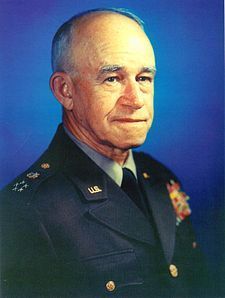 General Omar Nelson Bradley (February 12, 1893 – April 8, 1981)
General Omar Nelson Bradley (February 12, 1893 – April 8, 1981)
Born in Randolph County, Missouri, Bradley graduated from the U.S. Military
Academy at West Point, New York, in 1915, when he was commissioned into
the infantry. He served along the U.S.-Mexico border and, between World War I
and World War II taught mathematics at West Point.
In February 1941, he was promoted to (wartime) temporary rank of brigadier general
(bypassing the rank of colonel - this rank was made permanent in September, 1943). The
temporary rank was confered to allow him to command Fort Benning (he was the first from
his class to become even a temporary general officer). In February 1942, he was made a
temporary major general (a rank made permanent in September 1944) and took command of
the 82nd Infantry Division before being switched to the 28th Infantry Division in June.
Bradley did not receive a front-line command until early 1943, after Operation Torch. He had been
given VII Corps, but instead was sent to North Africa to be Eisenhower's front-line trouble-
shooter. He moved to London as commander in chief of the American ground forces
preparing to invade France in 1944. For D-Day (6 June 1944), Bradley was chosen to command
the US 1st Army, which alongside the British Second Army made up General Montgomery's 21st Army Group.
President Truman appointed Bradley to head the Veteran's Administration for two years after
the war. He is credited with doing much to improve its health care system and with helping
veterans receive their educational benefits under the G.I. Bill of Rights. Bradley became the
Army Chief of Staff in 1948. In 1949 he became the first Chairman of the Joint Chiefs of Staff
and served in that position throughout the Korean War.
In retirement, Bradley wrote his memoirs (A Soldier's Story), served on several corporate
boards, enjoyed attending horse races, and was a consultant for the film Patton.
General Omar Nelson Bradley is buried at Arlington National Cemetery in Arlington, VA.

 General Omar Nelson Bradley (February 12, 1893 – April 8, 1981)
General Omar Nelson Bradley (February 12, 1893 – April 8, 1981) Born in Randolph County, Missouri, Bradley graduated from the U.S. Military
Academy at West Point, New York, in 1915, when he was commissioned into
the infantry. He served along the U.S.-Mexico border and, between World War I
and World War II taught mathematics at West Point.
In February 1941, he was promoted to (wartime) temporary rank of brigadier general
(bypassing the rank of colonel - this rank was made permanent in September, 1943). The
temporary rank was confered to allow him to command Fort Benning (he was the first from
his class to become even a temporary general officer). In February 1942, he was made a
temporary major general (a rank made permanent in September 1944) and took command of
the 82nd Infantry Division before being switched to the 28th Infantry Division in June.
Bradley did not receive a front-line command until early 1943, after Operation Torch. He had been
given VII Corps, but instead was sent to North Africa to be Eisenhower's front-line trouble-
shooter. He moved to London as commander in chief of the American ground forces
preparing to invade France in 1944. For D-Day (6 June 1944), Bradley was chosen to command
the US 1st Army, which alongside the British Second Army made up General Montgomery's 21st Army Group.
President Truman appointed Bradley to head the Veteran's Administration for two years after
the war. He is credited with doing much to improve its health care system and with helping
veterans receive their educational benefits under the G.I. Bill of Rights. Bradley became the
Army Chief of Staff in 1948. In 1949 he became the first Chairman of the Joint Chiefs of Staff
and served in that position throughout the Korean War.
In retirement, Bradley wrote his memoirs (A Soldier's Story), served on several corporate
boards, enjoyed attending horse races, and was a consultant for the film Patton.
General Omar Nelson Bradley is buried at Arlington National Cemetery in Arlington, VA.
Published on June 09, 2012 04:45
June 8, 2012
Friday, June 8, 1934
We got our report cards. My semester grades: History S; English E; Expression S; Gym M; Latin S.
 Kansas City Blues - cap insignia
Kansas City Blues - cap insignia
Class Levels:
A - 1902-1907
AA - 1908-1945
AAA - 1946-1954
The Kansas City Blues are a former minor league baseball team located in Kansas City,
Missouri. The team was one of the eight founding members of the American Association.
The Blues did not field particularly competitive teams unil 1918, when they won the AA pennant.
The team won again in 1923, and again in 1929. They won the Junior World Series championship
that year, defeating the Rochester Red Wings of the International League in a best-of-nine series.
In 1936, the Blues became a farm club of the New York Yankees. They won the AA championships
five times in the 1930s and 1940s. When the American League Philadelphia Athletics moved to
Kansas City in 1955, the Blues moved to Denver, Colorado.

 Kansas City Blues - cap insignia
Kansas City Blues - cap insigniaClass Levels:
A - 1902-1907
AA - 1908-1945
AAA - 1946-1954
The Kansas City Blues are a former minor league baseball team located in Kansas City,
Missouri. The team was one of the eight founding members of the American Association.
The Blues did not field particularly competitive teams unil 1918, when they won the AA pennant.
The team won again in 1923, and again in 1929. They won the Junior World Series championship
that year, defeating the Rochester Red Wings of the International League in a best-of-nine series.
In 1936, the Blues became a farm club of the New York Yankees. They won the AA championships
five times in the 1930s and 1940s. When the American League Philadelphia Athletics moved to
Kansas City in 1955, the Blues moved to Denver, Colorado.
Published on June 08, 2012 04:45
June 7, 2012
Thursday, June 7, 1934
Pauline and I went to Irving graduation. She got a permanent. I went to her graduation at Central Junior.
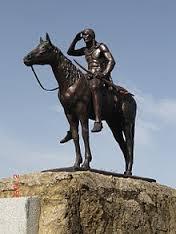 "The Scout"
"The Scout"
The Scout is a famous statue by Cyrus E. Dallin in Kansas City, Missouri. It is more than 10 feet tall, and depicts a Sioux Indian on horseback surveying the landscape. The Scout was conceived by Dallin in 1910, and exhibited at the 1915 Panama–Pacific International Exposition in San Francisco, where it won a gold medal. On its way back east, the statue was installed on a temporary basis in Penn Valley Park. The statue proved so popular that $15,000 in nickels and dimes was raised to purchase it through a campaign called "The Kids of Kansas City." The statue was dedicated in 1922 as a permanent memorial to local Indian tribes. It is currently located east of Southwest Trafficway in Penn Valley Park, which is south of downtown Kansas City.

 "The Scout"
"The Scout"The Scout is a famous statue by Cyrus E. Dallin in Kansas City, Missouri. It is more than 10 feet tall, and depicts a Sioux Indian on horseback surveying the landscape. The Scout was conceived by Dallin in 1910, and exhibited at the 1915 Panama–Pacific International Exposition in San Francisco, where it won a gold medal. On its way back east, the statue was installed on a temporary basis in Penn Valley Park. The statue proved so popular that $15,000 in nickels and dimes was raised to purchase it through a campaign called "The Kids of Kansas City." The statue was dedicated in 1922 as a permanent memorial to local Indian tribes. It is currently located east of Southwest Trafficway in Penn Valley Park, which is south of downtown Kansas City.
Published on June 07, 2012 04:45
June 6, 2012
Wednesday, June 6, 1934
Didn't take any tests today. Just sat around in Gym and then waited for Ruth Ray to walk home with me.
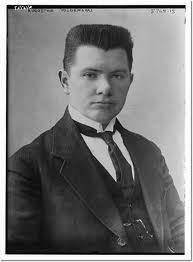 Augustine Voldemaras
Augustine Voldemaras
Dictator of Lithuania 1926-1929
Succeeded by Antanas Smetona
On June 6, 1934, followers of Augustine Voldermaras attempted a coup to overthrow
the Lithuanian government. Having already been convicted of high treason in May 1930 and
exiled to a village, Voldermaras was imprisoned for twelve months as a result of the coup attempt.
 Augustine Voldemaras
Augustine VoldemarasDictator of Lithuania 1926-1929
Succeeded by Antanas Smetona
On June 6, 1934, followers of Augustine Voldermaras attempted a coup to overthrow
the Lithuanian government. Having already been convicted of high treason in May 1930 and
exiled to a village, Voldermaras was imprisoned for twelve months as a result of the coup attempt.
Published on June 06, 2012 04:45
June 5, 2012
Tuesday, June 5, 1934
I took my Latin and English tests today. Made an M on both of them. Walked home with Ruth Ray.
[image error] 1934 Royal Typewriter - Model 10-KH-957
The Royal typewriter entered the market in 1906. It would grow to be one of the leading
brands that would dominate the market together with the Underwood and the Remington.
In 1914 the upright Royal 10 appeared (see above). This was the classic model with
beveled glass sides that would grow to be one of the market leaders.

[image error] 1934 Royal Typewriter - Model 10-KH-957
The Royal typewriter entered the market in 1906. It would grow to be one of the leading
brands that would dominate the market together with the Underwood and the Remington.
In 1914 the upright Royal 10 appeared (see above). This was the classic model with
beveled glass sides that would grow to be one of the market leaders.
Published on June 05, 2012 04:45
June 4, 2012
Monday, June 4, 1934
I took my History and Expression exams. Made an M on the first and an S on the Expression test.
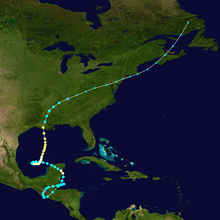 Storm path for the 1934 Central America Hurricane
Storm path for the 1934 Central America Hurricane
The 1934 Central America Hurricane is among the deadliest hurricanes on record. Although
a weak hurricane, it killed 1,000-3,000 people, mainly from landslides in Central America,
and spawned eight tornadoes when it made landfall in Louisiana. The storm formed on June
4 dissipated on June 18, doing $2.6 million (1934 USD) in damage.

 Storm path for the 1934 Central America Hurricane
Storm path for the 1934 Central America HurricaneThe 1934 Central America Hurricane is among the deadliest hurricanes on record. Although
a weak hurricane, it killed 1,000-3,000 people, mainly from landslides in Central America,
and spawned eight tornadoes when it made landfall in Louisiana. The storm formed on June
4 dissipated on June 18, doing $2.6 million (1934 USD) in damage.
Published on June 04, 2012 04:45
June 3, 2012
Sunday, June 3, 1934
NOTE: Ruth didn't write in her diary today.
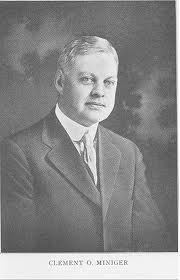 Clement O. Miniger - (November 11, 1874 - April 23, 1944)
Clement O. Miniger - (November 11, 1874 - April 23, 1944)
An American industrialist and philanthropist, Miniger founded the 'Electric Auto-Lite
Company' (now part of Honeywell) in 1911, acting as the company's president until 1934
and its chairman of the board from 1934 to 1944.
The Toledo Auto-Lite strike was a strike by a federal labor union of the American Federation
of Labor (AFL) against the Electric Auto-Lite company of Toledo, Ohio, from April 12 to June 3, 1934.
Miniger was instrumental in settling the strike.
The strike is notable for a five-day running battle between roughly 6,000 strikers and 1,300 members
of the Ohio National Guard. Known as the "Battle of Toledo," the clash left two strikers dead and more
than 200 injured. The strike is regarded by many labor historians as one of the three most important
strikes in U.S. history.

 Clement O. Miniger - (November 11, 1874 - April 23, 1944)
Clement O. Miniger - (November 11, 1874 - April 23, 1944)An American industrialist and philanthropist, Miniger founded the 'Electric Auto-Lite
Company' (now part of Honeywell) in 1911, acting as the company's president until 1934
and its chairman of the board from 1934 to 1944.
The Toledo Auto-Lite strike was a strike by a federal labor union of the American Federation
of Labor (AFL) against the Electric Auto-Lite company of Toledo, Ohio, from April 12 to June 3, 1934.
Miniger was instrumental in settling the strike.
The strike is notable for a five-day running battle between roughly 6,000 strikers and 1,300 members
of the Ohio National Guard. Known as the "Battle of Toledo," the clash left two strikers dead and more
than 200 injured. The strike is regarded by many labor historians as one of the three most important
strikes in U.S. history.
Published on June 03, 2012 04:45
June 2, 2012
Saturday, June 2, 1934
Straightened up the house today.
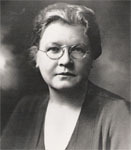 Louise Stanley - 1883-1954
Louise Stanley - 1883-1954
With a Ph.D in biochemistry, Stanley worked as a home economics instructor
at the University of Missouri from 1907 to 1911 and as chairwoman of the home
economics department from 1911 to 1923, when she was appointed Chief of the
National Bureau of Home Economics for the United States Department of
Agriculture. While serving in this position, she directed the first national farm
housing survey, which contributed to the establishment of programs to improve
rural living.
Throughout her life, Stanley was a memober of the Food and Nutrition Board of
the National Research Council. She was appointed to the American Standards
Association, making her the first woman to hold an official USDA position. A
National Agricultural Hall of Fame inductee, Stanley Hall at MU was named for her.
 Louise Stanley - 1883-1954
Louise Stanley - 1883-1954With a Ph.D in biochemistry, Stanley worked as a home economics instructor
at the University of Missouri from 1907 to 1911 and as chairwoman of the home
economics department from 1911 to 1923, when she was appointed Chief of the
National Bureau of Home Economics for the United States Department of
Agriculture. While serving in this position, she directed the first national farm
housing survey, which contributed to the establishment of programs to improve
rural living.
Throughout her life, Stanley was a memober of the Food and Nutrition Board of
the National Research Council. She was appointed to the American Standards
Association, making her the first woman to hold an official USDA position. A
National Agricultural Hall of Fame inductee, Stanley Hall at MU was named for her.
Published on June 02, 2012 04:45
June 1, 2012
Friday, June 1, 1934
Next week we have our final tests at school.
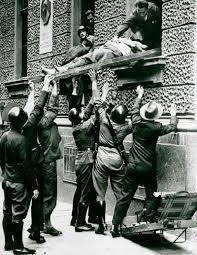 "Night of the Long Knives" - June 1, 1934
"Night of the Long Knives" - June 1, 1934
Also known as the "Röhm-Putsch", this was a purge that took place in Germany where
the Nazi regime carried out a series of political executions. Most of those killed were
members of the Sturmabteilung (SA), the paramilitary Brownshirts.

 "Night of the Long Knives" - June 1, 1934
"Night of the Long Knives" - June 1, 1934Also known as the "Röhm-Putsch", this was a purge that took place in Germany where
the Nazi regime carried out a series of political executions. Most of those killed were
members of the Sturmabteilung (SA), the paramilitary Brownshirts.
Published on June 01, 2012 04:45



